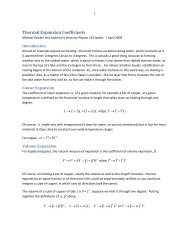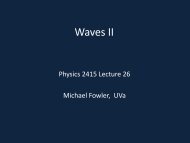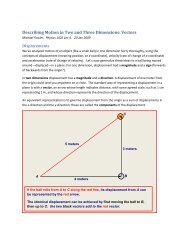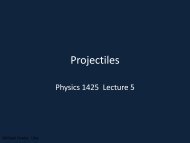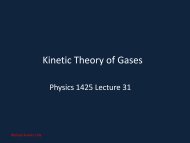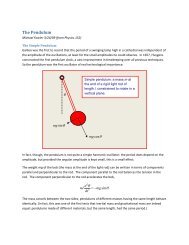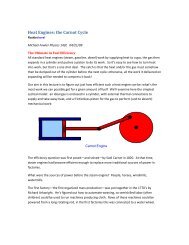Class Notes on Rotational Motion - Galileo and Einstein
Class Notes on Rotational Motion - Galileo and Einstein
Class Notes on Rotational Motion - Galileo and Einstein
You also want an ePaper? Increase the reach of your titles
YUMPU automatically turns print PDFs into web optimized ePapers that Google loves.
11If let go from a horiz<strong>on</strong>tal positi<strong>on</strong>, the weight will completely dominate the situati<strong>on</strong>, <strong>and</strong> accelerateddownwards very close to g. This means the far end of the light rod is forced downwards at close to 2g.Our example above is not that extreme, but the same idea.The Parallel Axis TheoremIf we know the moment of inertia of an object about a line through the center of mass, the moment ofinertia about any parallel line is easily found.We’ll prove this for a two-dimensi<strong>on</strong>al object (really a thin three-dimensi<strong>on</strong>al object):new axisrih m ir icenter of massThe moment of inertia of the two-dimensi<strong>on</strong>al object about any axisperpendicular to the object is simply related to that about theparallel axis through the center of mass.With the notati<strong>on</strong> in the diagram,ICM2 miri, <strong>and</strong> recall mr i i0.iiNow I m r m ( r h)newaxisiCMCM2 2i i i ii I 2h m r m hIMh2.ii iii2This is the Parallel Axis Theorem:I I Mh2newaxisCM .where h is the perpendicular distance between the new axis <strong>and</strong> the parallel axis through the center ofgravity. It’s easy to extend this proof to a three-dimensi<strong>on</strong>al object: taking the parallel axes to be in thez-directi<strong>on</strong>, replace r iwith (x i , y i ).




